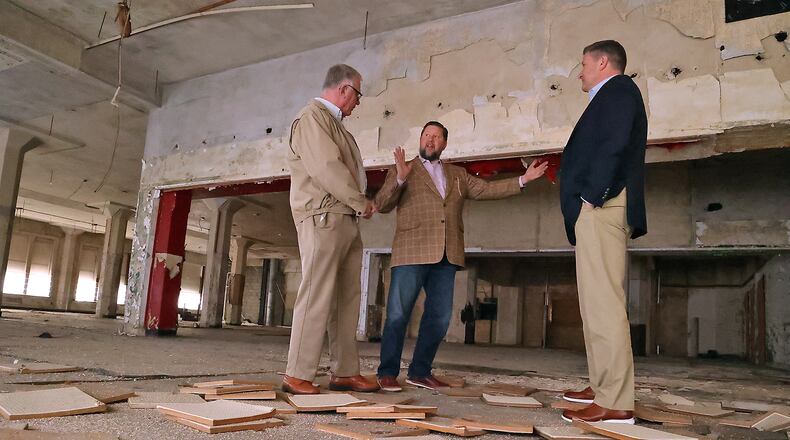The slated transformation of the structure that used to house the Wren Department store — known as the McAdams building — is the result of years of efforts to attract investment in the downtown area and mitigate risk associated with it.
However, those behind the project are working with the community to secure gap financing that would cover the rise in construction costs due to inflation. Work surrounding the former Wren department store building will include renovations to the existing structure as an addition to that building.
The goal is for construction to start later this year with the hope of having product available by late 2023. The price of the project is in the $20 million range, but costs could fluctuate, and $2 million in historic state tax credits have been secured for the project.
The Wren project is in addition to a proposal to build four, three-story townhomes on North Center Street in downtown Springfield. The project started in 2019 and is nearing the completion phase. Several of the units are already occupied.
The project aims to create a total of six buildings that will contain the nearly three dozen townhomes. Each townhome unit is approximately 1,300 square feet and prices start at around $220,000.
Efforts to revitalize the downtown, attract businesses to the area and rehabilitate buildings that in some cases have sat vacant or partially used for decades is nothing new.
The latest bid to bring more living opportunities downtown ties into an overall plan that sees job opportunities, local tourism drivers, retail, restaurants and the creation of housing are all playing off of each other.
“We brought a lot of jobs to the community,” said Mike McDorman, president and CEO of the Greater Springfield Partnership. “We are really good at retaining and expanding the jobs we have. That is an opportunity for places like downtown to grow retail and restaurant opportunities as well as residential. Now we are at that juncture where residential is getting ready to happen in a big way.”
In addition to the planned Wren project, renovations are taking place at the old State Theatre on South Fountain Street in an effort to turn it into a venue that would host music, show movies and hold events as well as potentially add a bar to the property.
There are also talks of building an event center that would be adjacent to the Kuss Auditorium, the Hollenbeck Bayley Creative Arts and Conference Center as well as the Springfield Family YMCA.
The idea is to go after regional sports tourism by creating an event center that would focus on basketball, volleyball and other types of competitions.
It would feature courts, equipment and potentially a competition sized pool. The goal is to bring in 2,000 to 3,000 in local tourism over the weekend, said McDorman, noting that it could also be marketed to state associations and smaller convention opportunities that could be held over the weekend.
During the week, the facility would accommodate regional teams who would play at the center, McDorman added.
There have been talks of creating this type of center since 2015. It would ideally be a 100,000 square feet facility, including 60,000 to 70,000 square feet of flat space.
It would be an around $20 million to $30 million project, depending if there will be a pool component to it and if the facility would be connected to the YMCA.
McDorman said that the next step now is going to the community and seeing if this would be something they would want. After that, the project would go into a fundraising phase.
“You are going to have some amazing synergy happening in downtown as momentum continues to increase with the developments that are planned,” McDorman said.
“You have people living in downtown, enjoying the amenities that are growing in downtown as well as visitors coming to your downtown every week enjoying those same amenities,” he added, noting how all these projects and efforts play a large role in adding to the vibrancy of the area.
Over the past few years there has been progress made in attracting partners to turn old property into new retail space, apartments and other fixtures of economic development.
“I would say that in the last two years, we have probably had more developers showing interest and wanting to see what we have and talk than what we have seen over the last 22 years,” said John Landess, the executive director of the Turner Foundation.
“So things have changed dramatically from that standpoint,” he added. The Turner Foundation has made large investments downtown and is also behind the planned conversation of the former Wren Department store building into apartments and new retail space.
They are working with developer Dillin LLC to make the Wren project happen.
The foundation has been involved in investing money into former buildings in downtown and that also includes renovations to create store fronts.
Years of investment by a variety of parties and individuals in downtown Springfield have led to new businesses emerging and new infrastructure to support growth, said Landess. It has also added to the confidence of potential investors who may have viewed the area to risky to invest in just a decade ago.
In addition, multiple organizations, foundations as well as governmental agencies have partnered to create a the nonprofit SpringForward in 2015 to aid in redevelopment efforts.
SpringFoward, in which Landess is on the Board of Directors, has been involved in major projects in downtown such as the townhome project on Center Street, the conversion of the former Myers Market building into CoHatch, the attraction of several businesses in the North Fountain Avenue Corridor as well as projects related to the State Theater and the Wren building.
“That is what we really want to see, is more people willing to take the jump to invest in the community. If we don’t invest in our own community, why would people want to come in from outside the community and put their money at risk,” Landess added.
Hundreds of millions of dollars have been invested in the redevelopment of downtown Springfield over the past 10 to 15 years, according to Tom Franzen, the assistant city manager and director of economic development for the city.
In recent years, old properties have seen millions of dollars in investment as well as new tenants. Corridors, such as North Fountain Avenue, that had seen large amount of vacancies a decade ago, now offer limited space as store fronts have been filled and old buildings have been rehabilitated.
However, some investments have not panned out and over the decade there have been business that have come and gone or projects that failed to build momentum.
The company that purchased a large building on east main street and branded it as the EF Hutton building filed for bankruptcy several years ago.
The EF Hutton building was in a state of a foreclosure process and the former State Theatre was also wrapped in that. However, it was able to be separated and those with SpringForward were able to sell the State Theatre property in December.
However, SpringForward’s chair Ted Vander Roest, who is also with the Springfield Foundation, did not disclose the private group that purchased the property or how much is being invested in the property.
But the plan is to turn it into a kind of venue that would serve an entertainment function and work associated with that project would mostly be renovations since the property is in good shape.
The State Theatre first opened in 1927 and was the flagship of the Chakeres Amusement Company. It continued to operate until 1990. It has now been used for live theater as well as screenings of silent movies, according to the Greater Springfield Partnership.
Property records show that SpringForward purchased the property for $223,800 from 1 East Main St LLC, according to the Clark County Auditors Office.
In other parts of the downtown, a new crop of businesses have emerged over the past several years and they are showing signs of longevity, said Daren Cotter, the Chief Financial Officer of the Turner Foundation.
“We had various tenants over the years. People would try things out. There have been starts and stops. But, eventually we have had some really good tenants step up and they have done a great job,” Cotter previous told this news organization pertaining to development efforts in the North Fountain Corridor.
That has been the result of renovation efforts that have seen hundreds of thousands of dollars invested to build up store fronts as well as attract a mix of retail and restaurants.
About the Author

